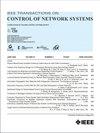未知分布目标的深度分散多智能体覆盖
IF 4
3区 计算机科学
Q2 AUTOMATION & CONTROL SYSTEMS
引用次数: 0
摘要
本文提出了一种新的多智能体系统体系结构,以快速、安全、分散的方式覆盖未知的分布式目标。代理间通信由具有固定拓扑结构的有向图组织。作者将智能体协调建模为一个分散的具有时变通信权值的领导者-追随者问题。针对这个问题,作者首先提出了一种将通信图转换为神经网络的方法,其中智能体可以由通信图的唯一节点表示,但可以由相应神经网络的多个神经元表示。然后,作者采用以质量为中心的策略,以分散的方式训练神经网络的时变通信权值。这意味着每个跟随体的观察区域都是由跟随体根据其内邻居的位置独立分配的。通过对神经网络的训练,可以实现安全分散的多智能体覆盖控制。尽管目标对智能体团队来说是未知的,但作者提供了一个证明所提出的多智能体覆盖方法的收敛性。通过对地面分布式目标的大规模多旋翼机队进行覆盖,验证了该方法的有效性。本文章由计算机程序翻译,如有差异,请以英文原文为准。
Deep and Decentralized Multiagent Coverage of a Target With Unknown Distribution
This article proposes a new architecture for multiagent systems to cover an unknown distributed target quickly and safely and in a decentralized manner. The interagent communication is organized by a directed graph with a fixed topology. The author models agent coordination as a decentralized leader–follower problem with time-varying communication weights. Given this problem setting, the author first presents a method for converting the communication graph into a neural network, where an agent can be represented by a unique node of the communication graph but multiple neurons of the corresponding neural network. The author then applies a mass-centric strategy to train time-varying communication weights of the neural network in a decentralized fashion. This implies that the observation zone of every follower agent is independently assigned by the follower based on positions of its in-neighbors. By training the neural network, the author can ensure safe and decentralized multiagent coverage control. Despite the target is unknown to the agent team, the author provides a proof for convergence of the proposed multiagent coverage method. The functionality of the proposed method is validated by a large-scale multicopter team covering distributed targets on the ground.
求助全文
通过发布文献求助,成功后即可免费获取论文全文。
去求助
来源期刊

IEEE Transactions on Control of Network Systems
Mathematics-Control and Optimization
CiteScore
7.80
自引率
7.10%
发文量
169
期刊介绍:
The IEEE Transactions on Control of Network Systems is committed to the timely publication of high-impact papers at the intersection of control systems and network science. In particular, the journal addresses research on the analysis, design and implementation of networked control systems, as well as control over networks. Relevant work includes the full spectrum from basic research on control systems to the design of engineering solutions for automatic control of, and over, networks. The topics covered by this journal include: Coordinated control and estimation over networks, Control and computation over sensor networks, Control under communication constraints, Control and performance analysis issues that arise in the dynamics of networks used in application areas such as communications, computers, transportation, manufacturing, Web ranking and aggregation, social networks, biology, power systems, economics, Synchronization of activities across a controlled network, Stability analysis of controlled networks, Analysis of networks as hybrid dynamical systems.
 求助内容:
求助内容: 应助结果提醒方式:
应助结果提醒方式:


